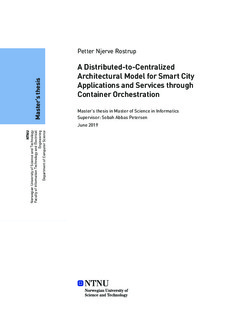| dc.contributor.advisor | Petersen, Sobah Abbas | |
| dc.contributor.advisor | Sinaeepourfard, Amir | |
| dc.contributor.author | Rostrup, Petter Njerve | |
| dc.date.accessioned | 2019-10-26T14:01:22Z | |
| dc.date.available | 2019-10-26T14:01:22Z | |
| dc.date.issued | 2019 | |
| dc.identifier.uri | http://hdl.handle.net/11250/2624630 | |
| dc.description.abstract | Bruken av IoT-enheter øker eksponentielt, og dette fører til en enorm økning i data generert fra slike enheter. For øyeblikket sendes det meste av de genererte dataene direkte til skyplattformer for behandling. Dette skaper fysisk lange avstander mellom enhetene og plattformene deres, noe som medfører økt belastning på nettverksinfrastrukturen og fastsetter høyere basiskrav for dem. Nye "smart city" IKT-systemer bør derfor utformes med tanke på dette for å redusere den totale unødvendige bruken av langdistanse nettverkskommunikasjon. Dette kan gjøres via beregninger og behandligner mellom enhetene og skyplattformene gjennom en "distributed-to-centralized" form for databehandling, kjent som "fog-to-cloud"-databehandling. Denne oppgaven undersøker hvordan dette beregningsparadigmet (computational paradigm) kan bli vedtatt i fremtidige IKT-systemer for en "smart city"-kontekst, samtidig som dataforvaltning tilrettelegges fra distribuerte kilder og opp til sky-løsninger. Den foreslår deretter en arkitektonisk modell (architectural model) basert på forskning gjort på standarder og status i "fog"-, "cloud"- og "fog-to-cloud"-databehandling. Denne forskningen er videre utformet som krav til design av modellen. Modellen utnytter konsepter som "containerization" og "container orchestration" for deretter å argumentere hvor egnede de er for et "smart city"-scenario.
En nyttig funksjon av dette er å muliggjøre bruk av et bredere utvalg av IoT-enheter som ressurser for driften av IKT-systemet. Gjennom implementering og evaluering av den arkitektoniske modellen, forsøker oppgaven å starte en diskusjon om standardisering av arkitekturer og beste praksis for bruk i smarte byer, nabolag og bygninger. | |
| dc.description.abstract | The usage of IoT devices is rising exponentially and this leads to a massive increase in data generated from such devices. Currently, most of the generated data is sent directly to cloud platforms for processing. This creates physically long distances between the devices and their platform, causing an increased strain on network infrastructures and setting higher baseline requirements for them. New smart city ICT-systems should therefore be designed with this in mind to lessen the total unnecessary usage of long distance network communications. This can be done by utilizing computation between the devices and the cloud platforms through a distributed-to-centralized form of computing known as fog-to-cloud computing. This thesis investigates how this computational paradigm can be adopted into future ICT-systems for a smart city context while facilitating data management from distributed sources and up to cloud computing solutions. It proposes an architectural model based on research done into the state of fog-, cloud- and fog-to-cloud computing. This research is then made into requirements for the design of the model to act as a scientific basis. The model utilizes concepts like containerization and container orchestration and argues for the suitability of those for a smart city scenario. A useful feature of this is to enable usage of a wider array of IoT-devices as resources for the ICT-system operation and runtime. Through implementing and evaluating the architectural model, the thesis then aims to start a discussion on standardization of architectures and best practices for use in smart cities, neighbourhoods and buildings. | |
| dc.language | eng | |
| dc.publisher | NTNU | |
| dc.title | A Distributed-to-Centralized Architectural Model for Smart City Applications and Services through Container Orchestration | |
| dc.type | Master thesis | |
